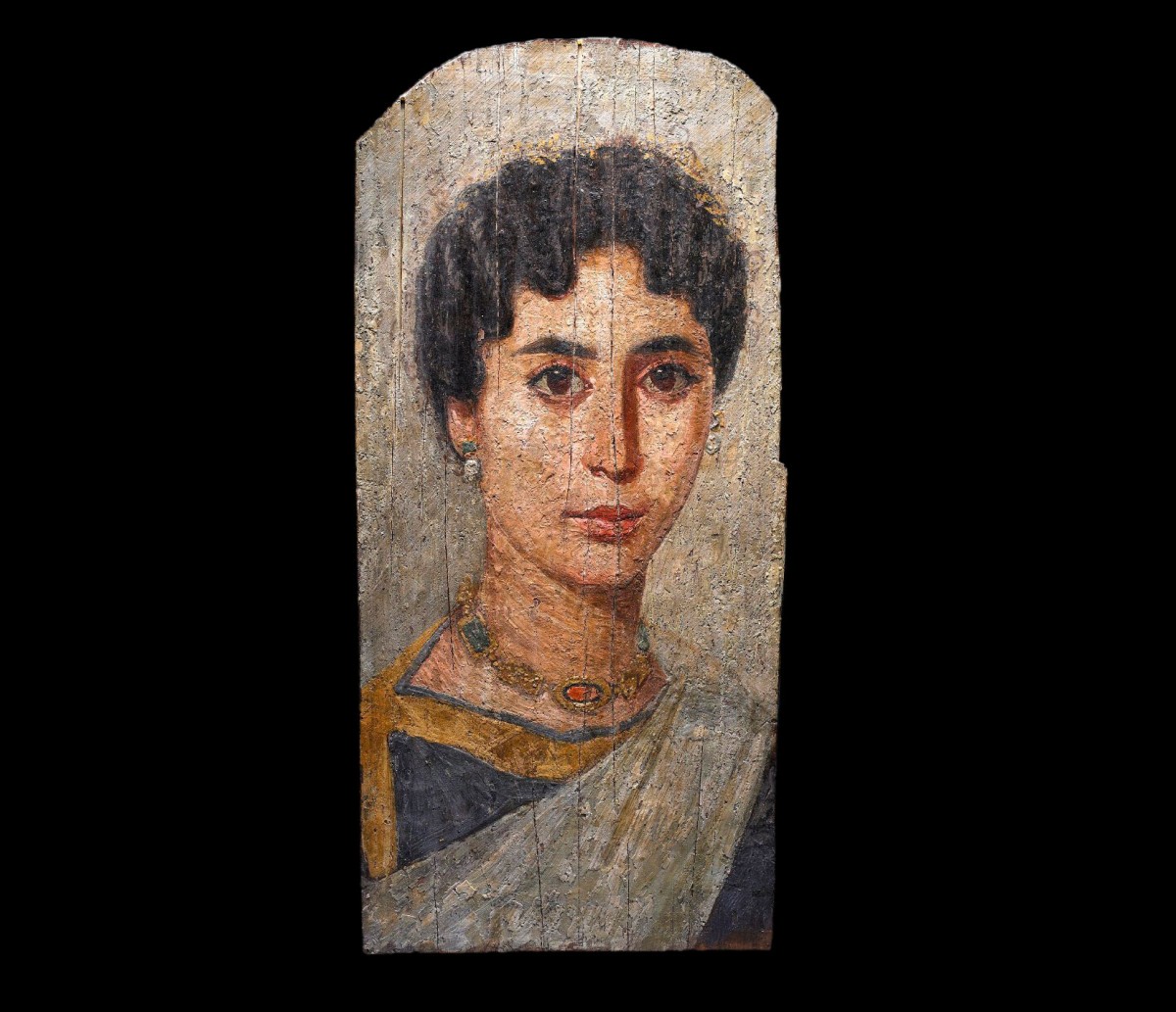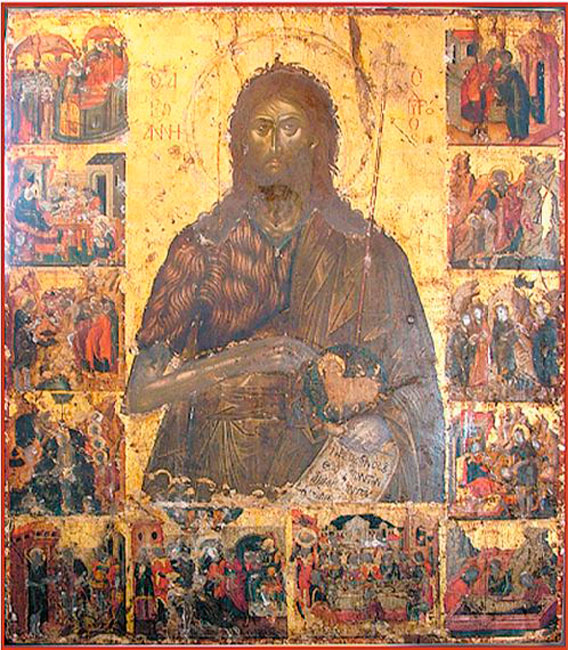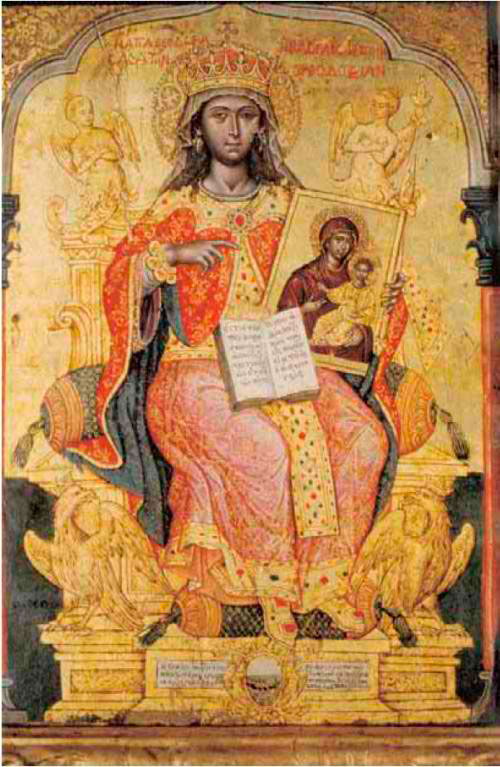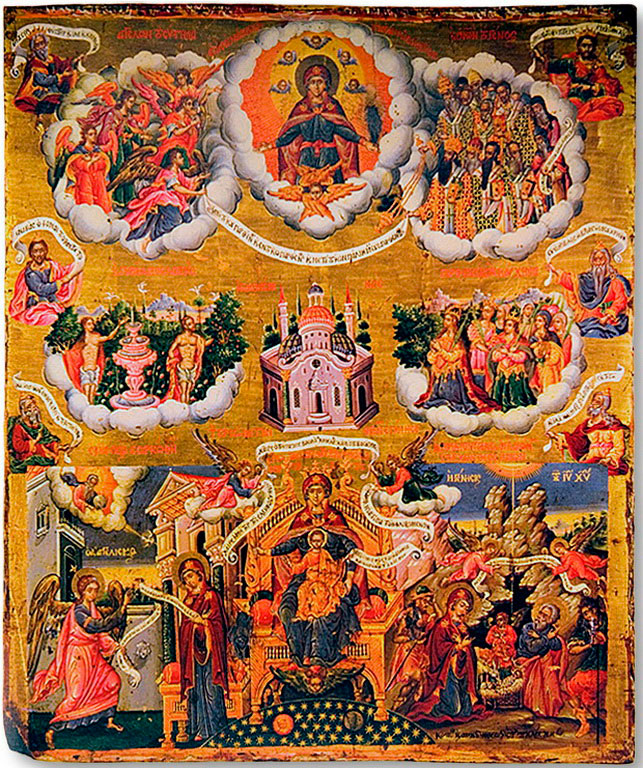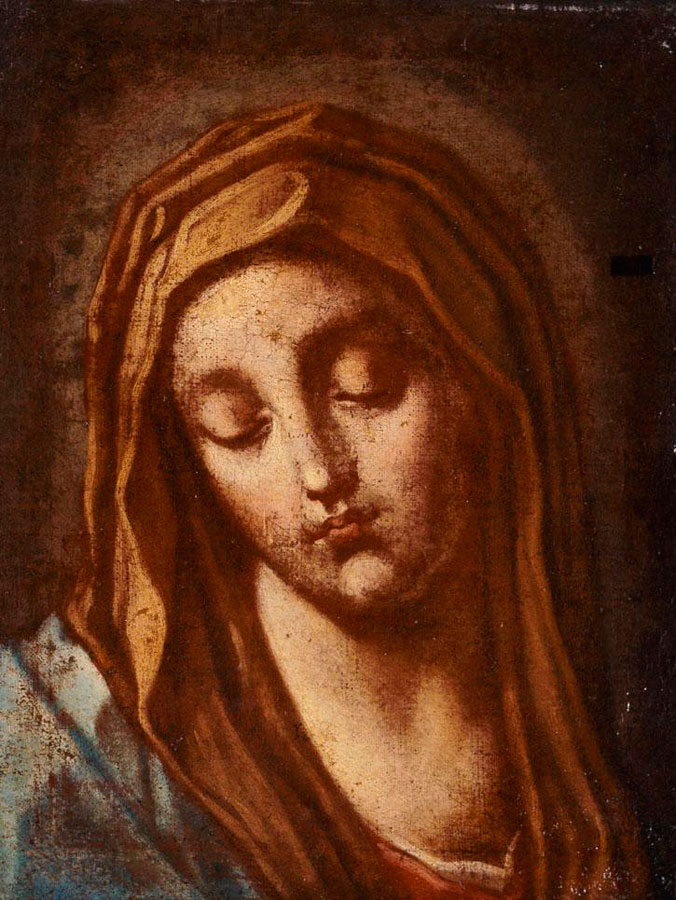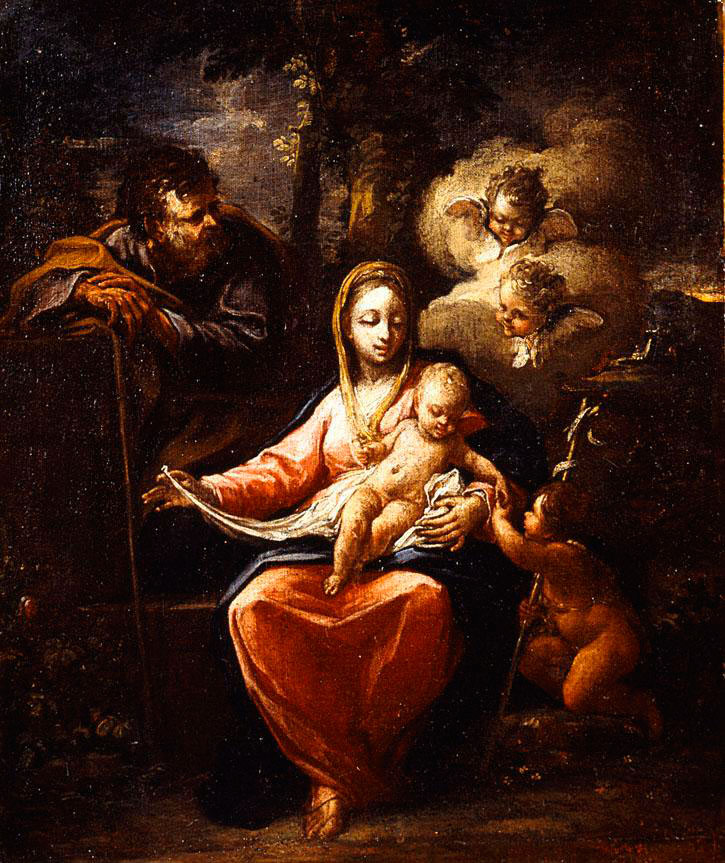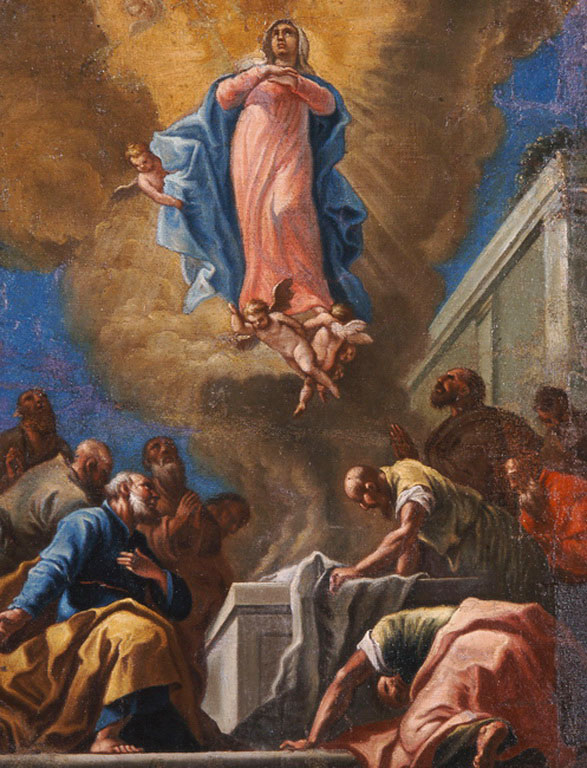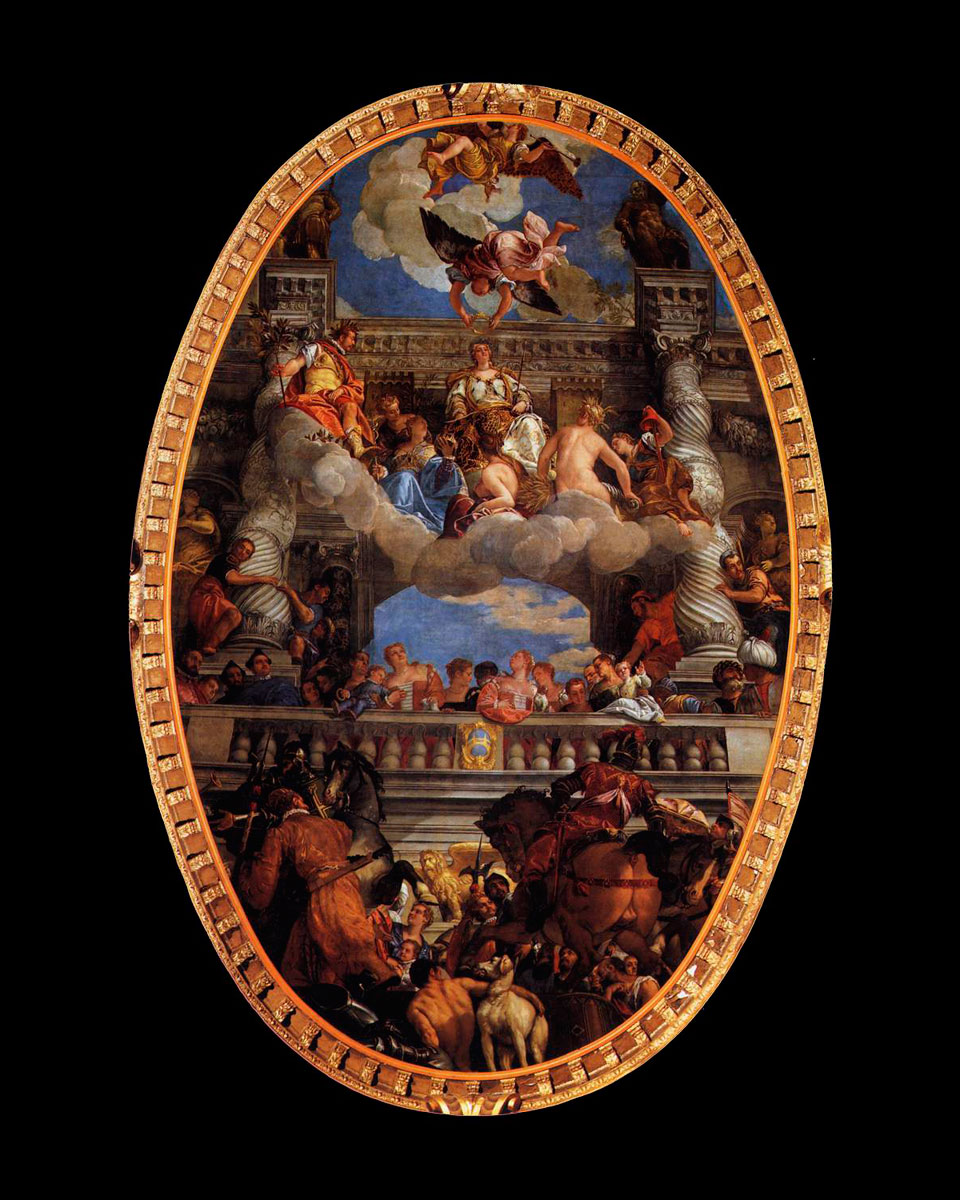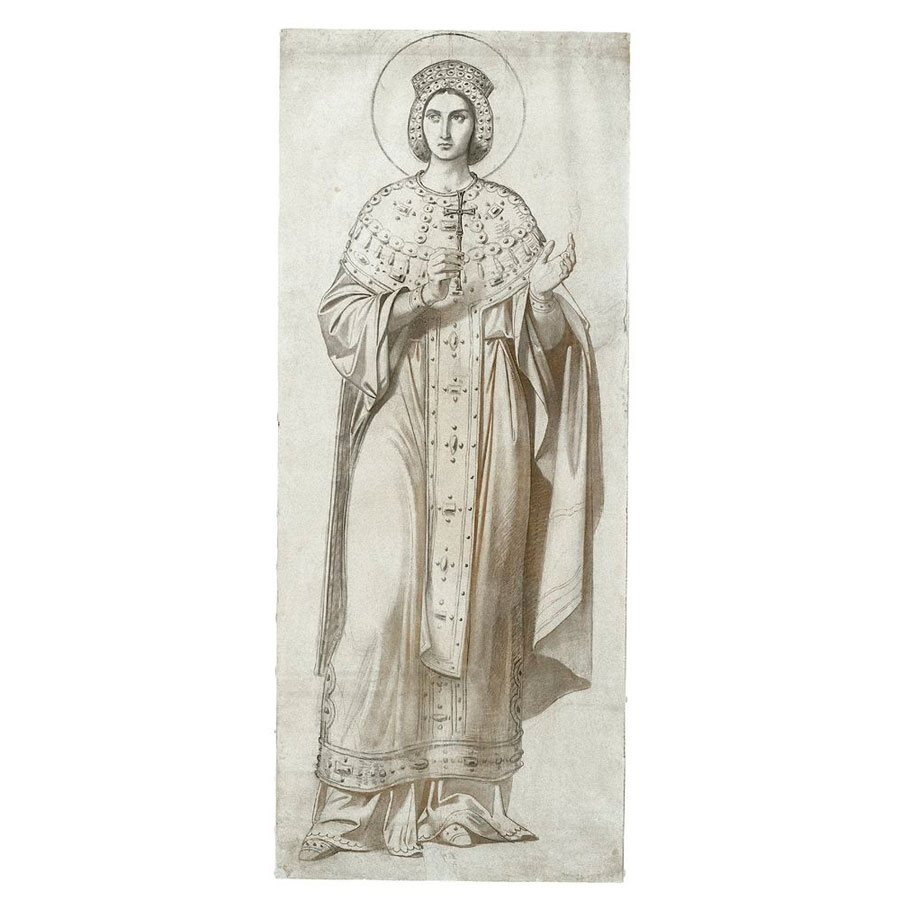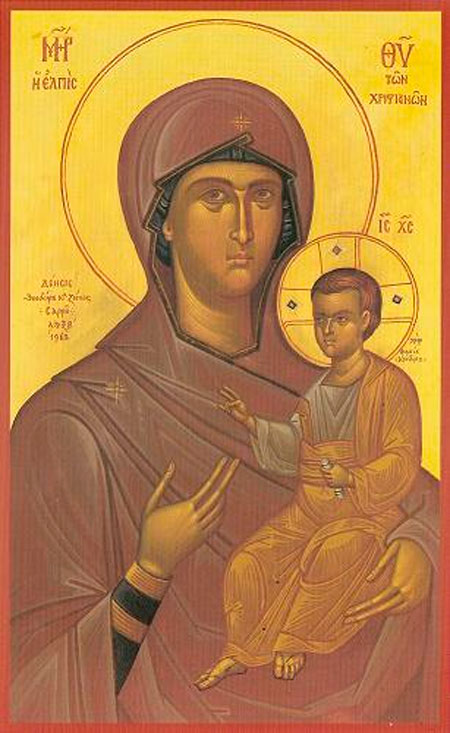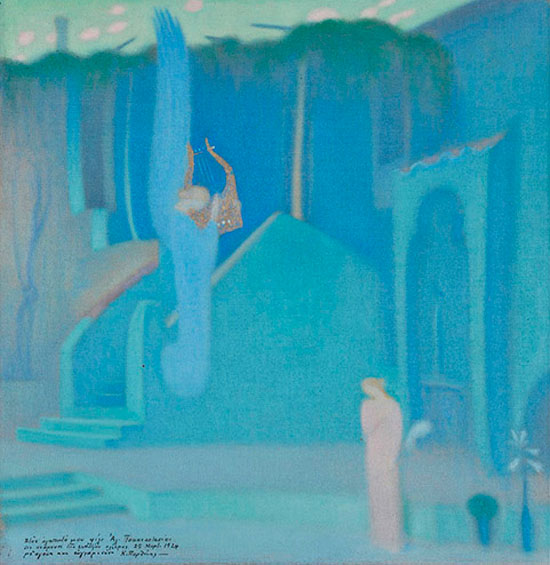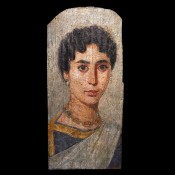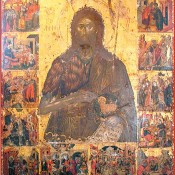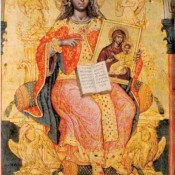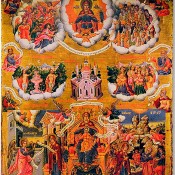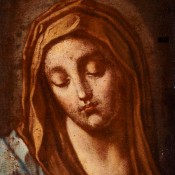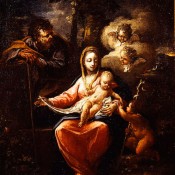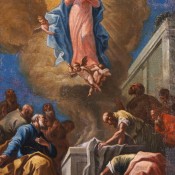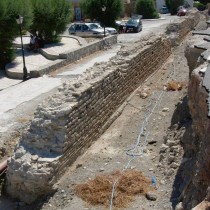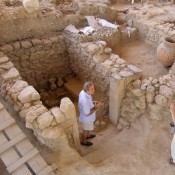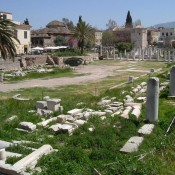The icon is a creation of Byzantine painting. The origins of the icon are to be found in art used in funerals (funerary art) which initially depicted faces with features of a general character, designed over the graves in honour of the dead. During the 4th century they would evolve as portraits. This genre took root, flourished and spread mainly in the East (note 1) and Asia Minor where it also thrived on account of the worship of Christian martyrs. A preference for icons was shown particularly by the Christians of Egypt, where the old tradition of mummy portraiture had survived.
The tendency to depict the saints either on walls as mosaics and wall paintings or as icons seems to have appeared very early on in Syria where the popular mentality was such that it asked for both a personal and spiritual encounter with the person to be honoured and venerated.
Nevertheless, it was not only the reverence and the veneration of icons but also a magic realism that sprung from the belief that the power of the spirit of the face depicted could work even through the icon itself, thus allowing one to appeal to it for his or her own personal aims and needs (note 2). This was not a new assumption but had its origins both in popular faith and in philosophy especially in Neo-Platonism where the deity penetrates things gradually and creatively filling them with its strength.
Plotinus taught almost similar things saying that according to the laws of “Sympathy” the icon unites with the deity being created by the artist and participates in its divine essence. When however the icon and the depicted face in some way come together as one, then a simple use of the icon unavoidably becomes an act of worship, the misunderstanding of which led to the terrible iconoclastic controversy in Byzantium (726-843). Even though there is evidence of icons being worshipped in the 4th and 5th centuries, this was not officially recognized by the church at least not till the mid 6th century.
The icon both as object of worship and as artistic expression belongs to the two spheres of faith and art. This dual nature makes it difficult to use appropriate criteria for its assessment. The artistic aspect of an icon comes second for someone looking upon it through the eyes of a believer. On the other hand, if someone uses only aesthetic, morphological and stylistic criteria when looking at an icon, they ignore its spiritual side. Therefore, because the icon’s primary aim is to convey both the idea and absolute spirituality in the face depicted (note 3) its manner of painting intends to express a different aesthetic approach to that of other painting.
The liturgical nature of icons
The Byzantine icon, therefore, was a timeless guardian of the peoples’ profound faith, exactly because it is primarily a work with a theological message and not a work of religious art. It does not specifically depict scenes with a religious content but promotes a theology reflecting the conceptual framework in which the Christian mystery is played out for all eternity (note 4). The icon touches on the everyday life of believers, just as the believers take part in the liturgy of the icon (note 5). Actually, in the church, which is the house of God, a liturgy is held for the icon, the icon participates as a “representative” mentally portraying the painted figures that take part in the liturgies and mysteries.
The hierarchical illustration of the interiors of orthodox postbyzantine churches as a miniature of the universe (note 6), shows that the icon is, in its general sense, of paramount importance and its main purpose is to transport the believer from his own world to that of God.
The Mother of God, as a bearer of incarnation is the link between two worlds, that of man and the irrational one of God. Illustrated themes relevant to the liturgy are also represented there for the believer to feel that by viewing them he or she becomes a participant. For example the Apostles’ Communion is depicted as are fathers of the church in a liturgy combined with the theme of the Melismos. These symbolic depictions are directly linked to the Mystery of Holy Communion thanks to which people communed with the incarnation, while the incorporation of the icons of Christ and the Virgin in the iconostasis aims to make man perceive these two worlds as one (note 7).
The creators of Byzantine art are organs of the church as was irrevocably defined by the 7th Ecumenical Synod (note 8). Their work is a manifestation of divine grace. A knowledge of art is therefore not all that is needed. Spiritual labour is also required as already requested by the Synod of Constantinople in 869/870 and other later ones up to the 18th century (Dionysius of Fournas) (note 9).
The brush work of the hagiographer must follow the demands of a religion with the Creator as its centre, projecting an extreme aestheticism which reaches a point of becoming art for art’s sake (l’art pour l’art) (note 10).
The western and secular origins of Byzantine art
The Fall of Constantinople in 1453 signalled both the collapse of the Byzantine empire and the beginning of a long period of agitation and change for enslaved Hellenism in all fields. The unbearable domination of the Ottomans, an uncultured conqueror of another faith, did not allow much room for Post byzantine hagiographers to continue or develop Byzantine art. This resulted in many of the painters seeking refuge on islands dominated by Venice, especially in Crete. The Venetians, despite being catholic, were of the same faith as the people they had conquered (note 11). Therefore, it was possible for byzantine and western religious art to coexist, to accept and influence each other and later on for elements of both arts to be assimilated by either of the two cultures.
As of the 16th century, mainly during the Cretan war of 1645- 1669, there was a terrifying wave of refugees migrating from both Crete and other parts towards the Ionian islands. This happened particularly after the fall, in 1669, of Candia, the greatest cultural centre of that period followed by the complete takeover of the island by the Turks. Within this climate, even Cretan painters went to study in Venice and then introduced to the Ionian islands the western styles they had assimilated (note 12).
Competent Cretan painters with a considerable oeuvre such as Emmanuel Tzanes Bouniales, Theodore Poulakis, Elias Moschos, Victor, Philotheos Skoufos all quickly establish their studios there and also acquire pupils including the following from the island of Zakynthos: G. Gryparis, Nik. Kallergis, Gerasimos Couloumbis and Sp. Stendas. Moreover, they proceed to mass produce icons and very often are too keen on imitating western originals. As a result, towards the end of the 18th century, the following two trends dominate post byzantine art : the first is conservative and remains close to the original byzantine traditional painting as represented by Dionysius of Fourna (note 13), the second is influenced by the techniques and iconography of Venetian painting. While seeming to develop the Cretan technique and tradition, this trend ends up as secular painting known as Painting of the Ionian Islands represented by the pioneers Panagiotis and Nicolaos Doxaras.
The work of Doxaras is evidence of his own need to support his painting from a theoretical point of view. It also reveals his obvious wish to transmit new aesthetic means and techniques to Greek painters, particularly to those of the Ionian Islands. He studies and twice translates, in 1720 and 1724, Leonardo da Vinci’s “Trattato della Pittura” (note 14).
In his monumental body of work, Doxaras realized all the new principles coming from Italy. In 1727, his painting of the heavens in the church of St Spyridon in Corfu takes after the “Apotheosis of Venice” by Veronese at the Palazzo Ducale.
This looking westward of post byzantine art moves towards a more general secular character, as it constantly finds new people to express it, such as Nicholas, Panagiotis Doxaras’ son (1706-1775) and Nicholas Koutouzis (1741-1813).
The painting of the church of St Menas in Lefkada, but mainly of the Faneromene church in Zakynthos, between 1753 and 1759, by Nicholas Doxaras are both of particular importance. Instead of Christ Pantocrator, as is usual in byzantine iconography, scenes of the life of the Virgin are depicted, following the styles of the catholic church (note 15).
On the contrary, the Virgin Mary plays a more important part in the Roman catholic church where the so called “Maria worship” is to be found.
This tendency to absorb western elements of art, originating from the “European” Roman catholic and protestant approach but adapted to the orthodox Christian faith, continues with Constantine Fanellis, Demetrios Byzantios or Hatziaslanis and Ludwig Thiersch (1825-1905). With Constantine Parthenis (1878-1965) who removed western elements from ecclesiastical art, there is, once again, a switch to byzantine styles and to folk art especially after the Asia Minor Catastrophe, around 1930 (note 16). The Lamentation and The Annunciation, works by Parthenis, both have a modernist almost revolutionary style distancing them from the purely byzantine.
The more general tendency of turning back, however, meant implementing the old techniques: namely of fresco for the murals, egg tempera for icons and the return of the two dimensional drawing without perspective or volume, as expressed mainly in the work of Demetrios Pelekasis (1881-1972) from Zakynthos and of Spyros Papaloukas (1892-1957). But this trend (of returning to old techniques) was to reach its peak in the paintings of the great Fotis Kondoglou (1895-1965) who consciously worked in the Byzantine tradition.
Secularism: a sign of progress or of alienation?
The adoption and assimilation of western styles in the painting of churches and icons in the Ionian islands was a natural result of the earlier acceptance and merging of alien elements which had then adapted, socially, ecclesiastically or economically, to the demands of the West. It is understandable that those who were subjugated should seek for better living conditions in a long period of oppression by such a harsh conqueror as the Ottoman. The Venetians, on their part, made sure to create incentives such as providing land, wages and other privileges for the subjugated to gradually embrace the western mentality. The phenomenon of transplanting elements of aesthetic perception and expression from the west can again be seen a century later, during the era under the Bavarians from 1833 to 1862. This time the Greek Nazarenes under King Otto transferred the pious painting of their German counterparts from Munich to the free new state (note 17). Apart from the Bavarians’ bad legacy handed down to Greece, the religious beliefs of Protestant Germany, inspired by the movement of Pietismus, spread to the Catholic countries and ultimately influenced the rational movement of the Enlightenment. Pietismus was against dogma and notably anticlerical, focusing on expressive emotional worship and personal piety. D.D. Triandafyllopoulos considers pietismus as a timely symptom of secularism (note 18). He specifically believes that its style as much as its content can corrupt devotional art.
He comments likewise on the Enlightenment, the movement whose main spokesman in Greece was Korais. By spreading the word of “metakenosis/transference”, Korais turned to an enlightened Europe and based his hopes on western culture for his country’s development. This last would act as a guide for Hellenism to renew its ties with both the great Greek tradition and its contact with the spirit of classical antiquity. On the other hand, in the eyes of a man of the Enlightenment such as Korais, the Greek Orthodox church seemed conservative and even backward.
The opinion of art historians of that time seems judgemental and even condemnatory, as they believe secularization to be a sign of alienation.
While the Nazarene models found such a great response in their day, so as to be considered by some as renewing and exalting byzantine art, nevertheless ecclesiastical art’s blind adjustment to this, Nazarene, style and the total banishment of byzantine art was finally interpreted as both a tendency towards secularism and a complete infiltration of renaissance elements.
Over the years, devotional art was subjected to this osmosis process of a variety of western elements. Specifically, they were either absorbed or adapted to that earlier severe form of byzantine art as established according to the “model” and the stylistic rules of Dionysius of Fourna (note 18). Despite the influence of western art on byzantine hagiography, the relationship between the two was unstable and not only due to the scepticism and doubt as to how much one influenced the other. The main reason was the possibility of renewing byzantine art without spoiling its liturgical nature or distorting its orthodox content.
Fotis Kondoglou (1895-1965) was the first to be led by this underlying concern to a conscious effort of a “renaissance” and a return to traditional models of byzantine painting. He was aiming to overcome the former’s increasing downgrading due to such influences of westernized art as German Nazarene painting, the School of Munich, revolutionary painting influenced by movements in Paris and the Romantic movement.
What distinguishes his work and makes him stand out among other painters is his profound faith and his religious conscience. N. Zias believes in fact that it is Kondoglou’s absolute understanding of the Icon’s theological importance in the life of the church as a whole, that differentiates this artist (note 19).
To arrive at such a result, it is necessary for the Church not to remain a patron of a standardized art, demanding absolute conformity to its tastes. It should behave instead like a nurse of devotional art offering nourishment to the artist. It, thus, becomes necessary for the church and the artist, acting as transmitters, to communicate and interact in order to convey the divine message’s spirituality (note 20).
Progress and adaptability in the life of the church, of which ecclesiastical painting is a part, should follow contemporary trends, but at the same time this should take place within the boundaries “imposed” by actual church tradition so as to preserve its purity.
What is therefore required in our times is for the church to have a real life and for it to effortlessly create a genuine continuity in our painting tradition.
This work is not only a burden to the church but also to the creative artist. Both sides are responsible for communicating the essence of the orthodox dogma. In the theologian’s case, preaching is the way of successfully spreading and interpreting the message. The artist must respond to social data by depicting it in his work so that the public, by seeing the already familiar figures, is able to understand, interpret and implement it.
The artist’s success, therefore, lies in his ability to prolong his work’s timeless value. The work’s life span depends directly on the degree of its influence and, last, on the degree to which its social dimension is satisfied by realizing society’s objectives.
Devotional icons as objects of (scholarly) study in the Museum
Since the era between the two world wars when artists such as Fotis Kondoglou return to byzantine models, a marked interest begins in protecting those works of art that convey the authentic form of orthodox religious art. George Lambakis (1854-1912) was such a pioneer in collecting devotional objects which, in this case, were holy relics and portable icons. It was he who went to great lengths to found the first Christian Museum for the protection and promotion of the holy symbols of orthodox faith. Although the church (still too weak to throw off the burden of westernization) supported Lambakis in his efforts, the writer Alexander Papadiamandis in his story “The Singer of the Easter Psalm” seems to accuse Lambakis of sacrilege.
It must have been very difficult for these people, whose beliefs followed an age old tradition, to accept Lambakis’ innovative idea of gathering all these holy symbols in a museum, which as an environment would have been alienating to them. This was the reason that his action was considered by many as leading to the secularization of ecclesiastical art.
The mentality of Greek intellectuals and artists was shaped more and more by ideas influenced by Europe. In the beginning, the first museums looked more like storerooms for simply guarding “cultural goods” that had been rescued. Gradually however, interest was shown in these “cultural goods” being exhibited because of their historical value (in the case of the Byzantine Museum, its guidelines were set between 1923 and 1960 by the then director George Soteriou).
It therefore becomes apparent that, during this period, the development of the museum on the one hand “served” the needs of each of the nation’s historical and political events such as the 1922 Catastrophe of Asia Minor, aiming at the people’s moral and spiritual rebirth. The perception of the work of art almost as a biological species demanded that the museum environment be a protective cover for the artefact (note 20).
As far as government authorities, archaeologists and the church were concerned, the placing of holy objects in museums was considered a compulsory function of the state so as to preserve the culture of the past. After a lot of complaints about the sacrilege of displaying icons in non religious places such as museums and of thus making it impossible to communicate with a primarily devotional art, it was decided at some point to reinstate them in churches. This, as believed, was the best way to retain the spirituality of the holy icons, since it was through their proper function that their original role would be realized (note 21).
The conscious choice of scholars, in this climate of perceiving culture in a new way, calls for the reinstating, exhibiting and protection of the artefacts preferably in their natural environment (note 22).
The attitude of contemporary museology
Although museums functioned on guidelines that basically remained the same, economic and social developments made museologists focus their interest on the public which is a vital part of a museum’s life and growth. The relationship in particular of the public with the museum is the most important issue with the specialists as the rates of the public’s turnout and response are what determine the policies to be followed by those responsible.
The late Demetrios Konstantios, head of the Byzantine and Christian Museum of Athens, referred in an interview to the trend for updating and adapting museums to the needs of the present day.
A good example is the redesigning of the new wing of the BCM of Athens which contains the museum’s permanent collection. It was the result of an interdisciplinary collaboration between archaeologists, architects-museographers, conservationists, museologists, museum educators, historians and specialists in computer science, proving that nowadays museums are treated seriously and with professionalism (note 23). The exhibition’s aim is to shed additional light on other aspects of byzantine society.
Jean-Pierre Armengaud, head of the French Institute in Athens, when organizing, in 1986, the “Exhibition of Icons” from private collections in Athens, stressed the need for collaboration and a two way relationship between the cultural organizations of various European countries for the promotion of Byzantine art at an international level.
The administration of the Byzantine Museum in Thessaloniki, moreover, often responding to requests of foreign cultural institutions, have, at times, organized exhibitions of lesser known works of post Byzantine art. The ultimate aim was for both Greek and foreign visitors of the museum, usually by looking at humble artifacts for everyday use, to get a sense of the continuity or lack of continuity between today’s human activities and those in the Byzantine period.
A visit to the museum really is a complex experience which, according to the model of Falk and Dirking, includes three dimensions; the personal, the social and the natural (note 24).The science of museology focuses its research more and more on the study of visitors and on ways of assessment, since it is always the public that is ultimately responsible for the continuation and survival of Byzantine art.
Athina Panou
Archaeologist-Museologist
